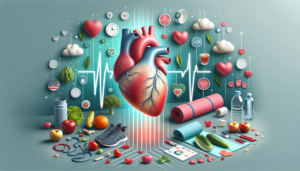Circulatory System Disorders: Understanding the Risks
Circulatory System Disorders: Understanding the Risks
What is the Circulatory System?
The circulatory system, also known as the cardiovascular system, is an intricate network responsible for transporting blood, nutrients, hormones, and oxygen throughout the body. Comprised of the heart, blood vessels, and blood itself, this system plays a crucial role in maintaining overall homeostasis. As a pivotal component of human physiology, any disturbances can result in various circulatory system disorders.
Key Components of the Circulatory System
- Heart: The central organ, divided into four chambers: left atrium, left ventricle, right atrium, and right ventricle. The heart pumps oxygenated and deoxygenated blood through the body and lungs, respectively.
- Blood Vessels: Arteries, veins, and capillaries create a vast network. Arteries carry oxygen-rich blood away from the heart, veins return deoxygenated blood, and capillaries facilitate nutrient exchange between blood and tissues.
- Blood: Composed of red blood cells, white blood cells, platelets, and plasma. Each component has distinct functions crucial for survival, such as oxygen transport and immune response.
Common Circulatory System Disorders
1. Coronary Artery Disease (CAD)
Coronary artery disease is characterized by the narrowing or blockage of the coronary arteries due to atherosclerosis, where plaque buildup narrows the arteries. CAD can lead to angina (chest pain) and heart attacks.
Risk Factors:
- High cholesterol
- Hypertension
- Smoking
- Diabetes
- Family history of heart disease
- Sedentary lifestyle
- Poor diet
Symptoms:
- Chest pain or discomfort
- Shortness of breath
- Fatigue
- Heart palpitations
2. Hypertension
Hypertension, or high blood pressure, affects nearly one in three adults. It occurs when the force of blood against artery walls is consistently too high.
Primary Causes:
- Genetics
- Excessive salt intake
- Lack of physical activity
- Obesity
Complications:
- Stroke
- Heart attack
- Heart failure
- Kidney damage
Symptoms:
Often “the silent killer,” hypertension may not show symptoms until significant damage has occurred.
3. Heart Failure
Heart failure, or congestive heart failure, describes a condition in which the heart cannot pump blood efficiently. This can result from prior heart conditions such as CAD or hypertension.
Types:
- Systolic heart failure (reduced ejection fraction)
- Diastolic heart failure (preserved ejection fraction)
Risk Factors:
- Age
- Previous heart attack
- Diabetes
- Obesity
Symptoms:
- Shortness of breath
- Swelling in legs or abdomen
- Fatigue
- Persistent cough
4. Arrhythmias
Arrhythmias refer to irregular heartbeats, which can be too fast, too slow, or erratic. They can occur in the heart’s atria or ventricles.
Types:
- Atrial fibrillation
- Ventricular tachycardia
- Bradycardia
Risk Factors:
- Heart disease
- Electrolyte imbalances
- Stress
- Alcohol consumption
Symptoms:
- Fluttering in the chest
- Dizziness
- Fainting
- Chest discomfort
5. Peripheral Artery Disease (PAD)
Peripheral artery disease involves narrowed arteries, reducing blood flow to the limbs. This condition can lead to severe complications if untreated.
Risk Factors:
- Atherosclerosis
- Smoking
- Diabetes
- High cholesterol
Symptoms:
- Leg pain or cramping during activity
- Weak or absent pulses in the legs
- Sores or wounds on legs that do not heal
6. Stroke
A stroke occurs when blood supply to the brain is interrupted, impairing brain function. This can result from a blocked artery (ischemic stroke) or a ruptured blood vessel (hemorrhagic stroke).
Risk Factors:
- Hypertension
- Heart disease
- Diabetes
- High cholesterol
Symptoms:
- Sudden numbness or weakness, especially on one side of the body
- Confusion or trouble speaking
- Severe headache with no known cause
- Trouble seeing in one or both eyes
Diagnostic Procedures
1. Blood Tests
Blood tests can help determine cholesterol levels, blood sugar, and signs of inflammation or heart disease.
2. Imaging Tests
- Echocardiogram: An ultrasound used to visualize heart structures.
- Electrocardiogram (ECG): Measures the heart’s electrical activity.
- Angiography: X-ray imaging of blood vessels enhanced with a contrast dye.
3. Stress Tests
These tests evaluate the heart’s response to physical stress, identifying complications that may not be apparent at rest.
Prevention Strategies
Lifestyle Changes
-
Diet:
- Adopting a heart-healthy diet rich in fruits, vegetables, whole grains, and lean proteins can vastly improve cardiovascular health.
- Reducing salt and saturated fat intake can also lower the risk of hypertension and prevent CAD.
-
Exercise:
- Regular physical activity strengthens the heart and helps control weight. Aim for at least 150 minutes of moderate-intensity aerobic exercise weekly.
-
Weight Management:
- Maintaining a healthy weight reduces the burden on the heart and lowers the risk of hypertension and diabetes.
-
Smoking Cessation:
- Quitting smoking significantly decreases the risk of developing cardiovascular diseases.
- Stress Management:
- Techniques such as yoga, meditation, and mindfulness can reduce stress, a known risk factor for heart disease.
Regular Health Monitoring
Regular check-ups with a healthcare provider can help screen for high blood pressure, cholesterol levels, and other potential risk factors. Early detection leads to timely intervention and better outcomes.
Treatment Options
Medications
- Antihypertensives: Medications used to manage hypertension and reduce the risk of heart damage.
- Statins: These help lower cholesterol levels to reduce the risk of heart disease.
- Anticoagulants: Used to prevent blood clots, essential for patients with arrhythmias.
Surgical Procedures
- Angioplasty and Stenting: A procedure to open blocked arteries and restore blood flow.
- Coronary Bypass Surgery: Creating a new pathway for blood to flow to the heart by bypassing blocked arteries.
- Pacemakers/Implantable Defibrillators: Devices used to regulate heart rhythms in cases of severe arrhythmias.
Lifestyle Modifications Post-Diagnosis
Patients diagnosed with circulatory system disorders should adhere to recommendations for lifestyle modifications to enhance healing and prevent recurrence.
- Dietary Adjustments: Following specific dietary guidelines provided by healthcare professionals can contribute to improved heart health.
- Exercise Plans: Structured exercise programs may be necessary under medical supervision for some patients.
- Regular Follow-ups: Maintaining close communication with healthcare providers ensures ongoing management and adaptation of treatment plans based on individual needs.
The Role of Genetics
Family history plays a significant role in the risk of circulatory system disorders. Genetic predispositions can amplify susceptibility to conditions such as CAD and hypertension. Genetic testing, when appropriate, may help assess risk in individuals with a family history of heart-related issues.
Conclusion on Understanding Risks
Understanding the risks associated with circulatory system disorders is essential for developing prevention and management strategies. Awareness of symptoms, regular monitoring, and lifestyle modifications play crucial roles in maintaining cardiovascular health and addressing circulatory problems effectively. Whether through lifestyle changes, medical interventions, or routine screenings, individuals can take charge of their heart health and reduce the likelihood of serious complications.








